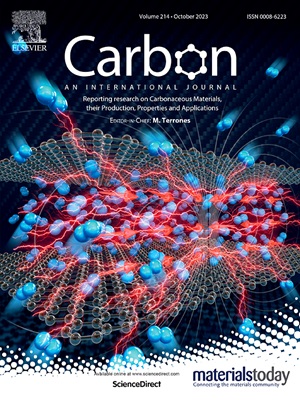Intensive oxidase-like activity of carbon dots nanozymes modulated with phosphoric acid for sensing
IF 11.6
2区 材料科学
Q1 CHEMISTRY, PHYSICAL
引用次数: 0
Abstract
Development and modulation of carbon dots based nanozymes (CDNs) with pleasing oxidase-like activities remains a challenging and meaningful endeavor. Herein, aiming at enhanced photocatalytic capabilities of CDNs, a phosphoric acid (H3PO4) synthesis strategy was proposed through series of remarkable CDNs development and elaboration, named as P-CDNs. In this modulated strategy, reagent of H3PO4 not only provides P atoms into the carbon dots’ backbone, generating defects for π-electron; but also functionalizes as interbedded phosphate, providing active electron sites to further promote electron efficacy and oxidase-like activities. The capacity of catalytic TMB was used to exemplify the oxidase-like activities of CDNs, and the results confirmed that the catalytic performance of P-CDNs was 3.25 times than that of the reference CDs. Based on the crackajack oxidase-like activity of P-CDNs, a smartphone remote analysis system was readily constructed to sensitive colorimetric/fluorescence dual mode response to diazotization reaction represented by nitrite. Our synthesis strategy not only provides guidance for the design of highly active CDNs but also offers directions for synthetic chemistry and materials science.

磷酸调节碳点纳米酶的高氧化酶样活性
开发和调控具有良好氧化酶样活性的碳点基纳米酶(cdn)仍然是一项具有挑战性和意义的工作。本文以增强cdn的光催化能力为目标,通过一系列cdn的开发和完善,提出了一种磷酸(H3PO4)合成策略,命名为p - cdn。在该调制策略中,H3PO4试剂不仅使P原子进入碳点的主链,产生π电子缺陷;但也作为互层磷酸盐功能化,提供活性电子位,进一步促进电子效能和氧化酶样活性。用催化TMB的容量来表征cdn的类氧化酶活性,结果证实p - cdn的催化性能是参考cd的3.25倍。基于p - cdn的裂解氧化酶样活性,构建了以亚硝酸盐为代表的重氮化反应的灵敏比色/荧光双模式智能手机远程分析系统。我们的合成策略不仅为高活性cdn的设计提供了指导,而且为合成化学和材料科学提供了方向。
本文章由计算机程序翻译,如有差异,请以英文原文为准。
求助全文
约1分钟内获得全文
求助全文
来源期刊

Carbon
工程技术-材料科学:综合
CiteScore
20.80
自引率
7.30%
发文量
0
审稿时长
23 days
期刊介绍:
The journal Carbon is an international multidisciplinary forum for communicating scientific advances in the field of carbon materials. It reports new findings related to the formation, structure, properties, behaviors, and technological applications of carbons. Carbons are a broad class of ordered or disordered solid phases composed primarily of elemental carbon, including but not limited to carbon black, carbon fibers and filaments, carbon nanotubes, diamond and diamond-like carbon, fullerenes, glassy carbon, graphite, graphene, graphene-oxide, porous carbons, pyrolytic carbon, and other sp2 and non-sp2 hybridized carbon systems. Carbon is the companion title to the open access journal Carbon Trends. Relevant application areas for carbon materials include biology and medicine, catalysis, electronic, optoelectronic, spintronic, high-frequency, and photonic devices, energy storage and conversion systems, environmental applications and water treatment, smart materials and systems, and structural and thermal applications.
 求助内容:
求助内容: 应助结果提醒方式:
应助结果提醒方式:


